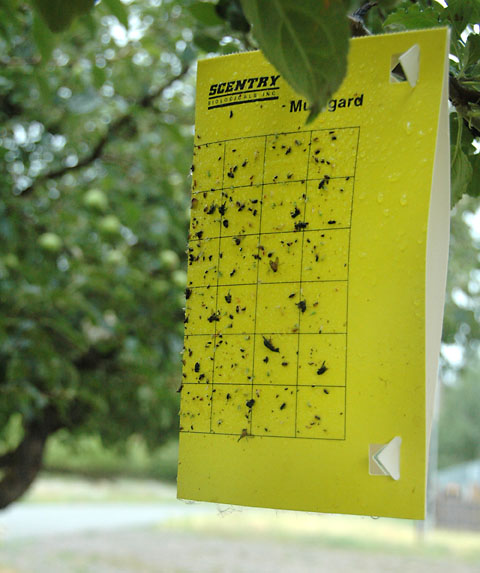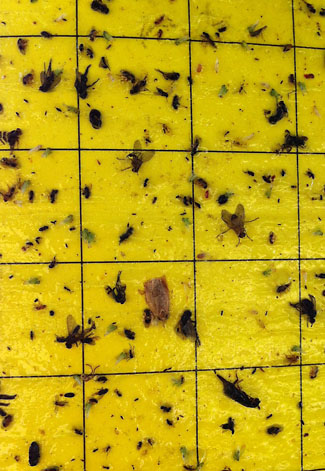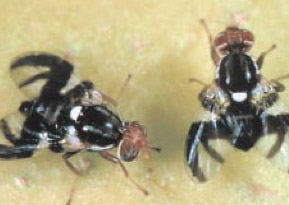home | internet service | web design | business directory | bulletin board | advertise | events calendar | contact | weather | cams

 About 3000 insect traps like this are set each year in Okanogan County. Photo by Sheela McLean About 3000 insect traps like this are set each year in Okanogan County. Photo by Sheela McLean
Pest Patrol Using bright yellow sticky pieces of paper hanging in local trees, the Washington State Department of Agriculture is out for a local orchard enemy: the apple maggot. Apple maggots, Rhagoletis pomonella, lay eggs just under the skin of the apples. The apples end up “brown, mushy and inedible” according to the Okanogan County Commissioners website. They can also get into crabapples, cherry, pears, plums, and apricots. Insect traps to detect apple maggots are set in 300 to 600 potential host tree sites in Okanogan County each year. “We have one very polite and friendly seasonal trapper, Neal Wentz, covering all of Okanogan County including the Methow Valley,” said Mike Klaus, entomologist at the Washington State Department of Agriculture. “WSDA has trapped for apple maggot and Gypsy moth in this area at varying levels since 1983.” Trap placement begins around June 25 after the apple maggot flies emerge from their pupae. Traps are removed by the end of September. The sticky material on the traps includes ammonium carbonate (known in older times as smelling salts) to attract adult apple maggot flies. It is slightly toxic and can cause eye irritation. “While we mainly catch non-economic fruit flies like the snowberry maggot fly and rose hip maggot fly, we sometimes catch the apple maggot fly on our traps. When that happens, we work with the Okanogan Horticultural Pest and Disease Board to try to keep the fly from establishing in the area,” said Klaus. The data is also presented to the apple maggot working group at their regular winter meeting.  The traps are then collected and studied, looking for apple maggot flies. Photo by Curtis Edwards The traps are then collected and studied, looking for apple maggot flies. Photo by Curtis Edwards
When an infestation is found, the Pest Board contacts the landowner. The Methow has many second-home owners, said Pest Board agent Dan McCarthy. “I’ve contacted non-residents in Seattle, Tacoma, Florida, France, all over the place.” He said the owners are often totally unaware of the apple maggots, which not only like old orchards, but also the native hawthorn trees that live in the Methow’s riparian zones. “The practical solution is to get rid of the tree,” McCarthy said, but pesticides are also sometimes used. The Methow Valley’s big freeze of December 1968, which officially set a state record of -48 degrees Farenheit, damaged or destroyed many of the commercial orchard trees in the Methow Valley, said McCarthy. And it’s the abandoned orchards with re-grown trees that are the main problem for apple maggots. Between Twisp and Carlton three infestations have been found in the last six or seven years. The old trees were removed in the infested old orchards. “The following year (after each detection and tree removal), we have not had a recurring fond of apple maggot in that area,” McCarthy said. When the apple maggots are not detected early, and have time to develop multi-generational and multi-aged infestations, an area might be quarantined. “Part of Chelan County was quarantined last year,” McCarthy added. The Washington State law that stands behind apple maggot control is RCW 15.09, which establishes pest boards, right of entry to private property, penalites, and so on. “In Okanogan County growers are proactive in their management practices to reduce the use of pesticides and provide abundant, inexpensive and healthy fruit. It is imperative that we protect these valuable crops from injurious pests and diseases,” according to the county’s Pest Board web page. The Pest Board “provides information in controlling horticultural pest and diseases through Washington State University Cooperative Extension spray programs and as service to home owners offers free removal of fruit trees.” The apple maggot “can be brought in by travelers carrying infested fruit from areas like Portland, Oregon, western Washington or even the eastern US” said Wentz. “The tree fruit industry provides employment for 30% of the population in Okanogan County. Apple growers produce as large a crop as the states of New York, Michigan, Pennsylvania and California and equal to the combined production of Virginia, North Carolina, West Virginia, Idaho and Oregon,” according to the Okanogan County Commissioners website. Commercial apple pest enemy number one is the codling moth which produce the traditional wormy apple, according to McCarthy. The yellow traps do not detect codling moths.  Adult apple maggot flies. Photo courtesy Washington State University Adult apple maggot flies. Photo courtesy Washington State University
A side note from Wikipedia: The apple maggot, Rhagoletis pomonella is significant evolutionarily in that the race of this species that feeds on apples spontaneously emerged from the hawthorn feeding race in the 1800 - 1850 time frame after apples were introduced into North America. The apple feeding race does not now normally feed on hawthorns and the hawthorn feeding race does not now normally feed on apples. This constitutes a possible example of an early step towards the emergence of a new species, a case of sympatric speciation. The emergence of the apple race of Rhagoletis pomonella also appears to have driven formation of new races among its parasites.
7/27/2012 Comments
|